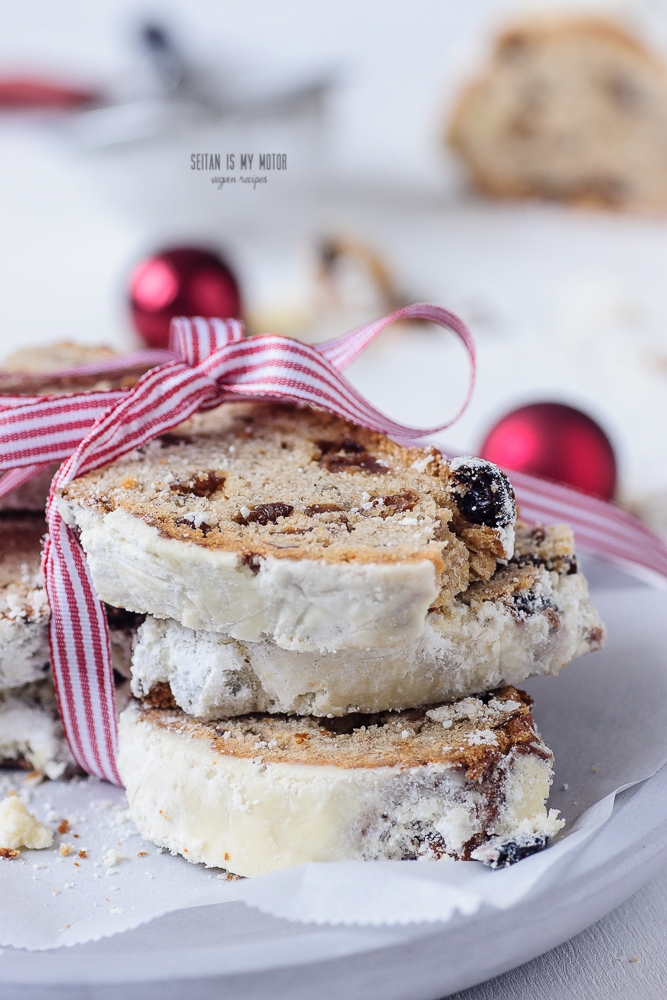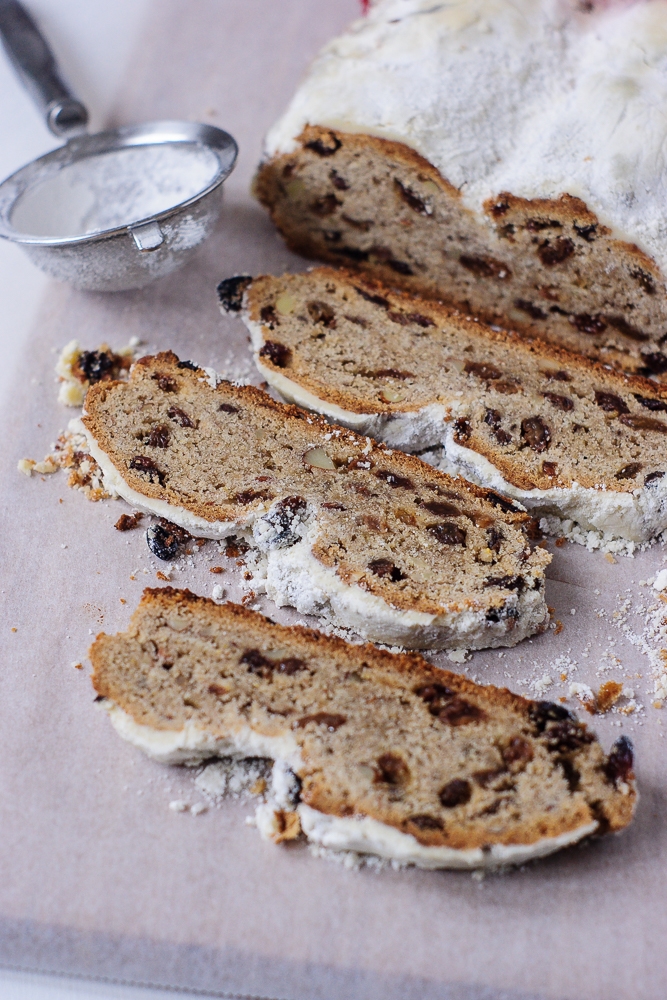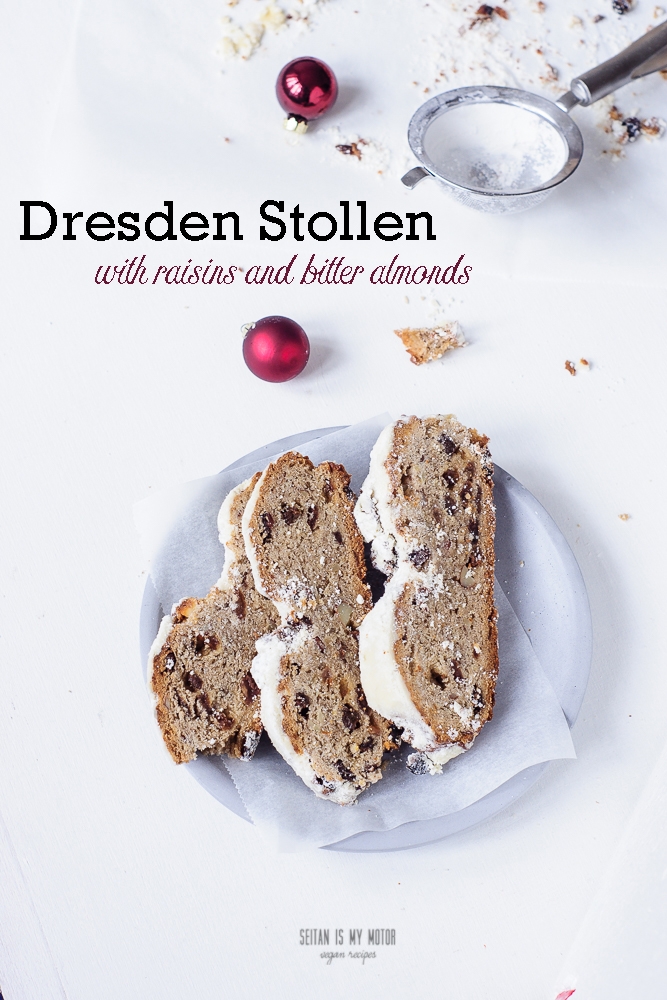Recently there was an interesting studio discussion on the radio. There were a couple of experts discussion marzipan. They were talking about traditional ingredients and methods of marzipan production. It was absolutely amazing. People were calling in, asking questions or sharing their methods and tricks. They sounded so respectful towards these old methods and recipes. They were very humble when sharing their own experiences. It’s really hard to describe how fascinating this was. But it reminded me of some very important traditions we have in this town. One of them is baking stollen for Christmas. And for the last couple of days I have felt like Alice in Wonderland’s white rabbit: „Oh dear! Oh dear! I shall be too late!“ I wanted to make a stollen this year but it’s only a few more days until Christmas. That is too late!
Stollen or striezel, as it is called in Dresden, is a very heavy yeast bread that usually has to be stored for quite some time before you eat it. The liquid that comes from some of the ingredients has to be distributed evenly. It also takes time for the flavours to develop properly. Of course there are many different opinions on how long to store a stollen. Some say four weeks, others say two. Some people think that the flavour won’t improve much more after a week. I think you’ll just have to wait and see how you like your stollen best. Cut off a couple of slices for Christmas and then wrap the stollen again and see if flavour and texture improve over time.
By the way, I don’t deserve to name my stollen Dresden stollen because it is missing two key ingredients: butter and candied citrus peel. The butter is pretty obvious. And the candied citrus peel? Well, I hate it. As a kid I picked it from my grandmother’s stollen every year and I am still not getting used to the weird bitter and overwhelming flavour that comes from the candied peel bits. Ah well, this is hard to describe: I don’t mind the flavour so much, it adds lots of aroma, I just hate the huge chunks of it. So I use ground and dried clementine peels instead of candied citrus. For your own stollen you can use either the ground peel or add 150 g of candied citrus peel to your dough. Whatever you like!

Oh, and one more thing: This stollen calls for bitter almonds. I know that they can be hard to find in many parts of the world. If you don’t have access, use almond extract instead. My recipe contains 5 g of bitter almonds, so maybe go with one teaspoon of natural almond extract.
Dresden stollen is famous. And it’s protected. You can only make it if you follow all the rules and add exactly the ingredients called for. One of them is butter. Lots of it. For two parts flour you use one part butter. You will also need the same amount of rum soaked raisins. After baking you brush the hot stollen with more fat. A day later you dust it with tons of powdered sugar. It is rich in calories, that is for sure. But stollen is a very special treat that is only baked in December and traditionally the loaves where supposed to last until Easter, which means you’d only eat a slice or two when you came together for a Sunday afternoon coffee table round. I would not suggest to reduce the amount of fat. I mean you can do it, but it will change your results completely. You won’t be able to store your stollen for very long and preserve the texture and taste. This is a local, very famous, and very traditional specialty that is enjoyed by people all over Germany. I really think it’s worth trying if you never have tasted it before. And if you start right now, you’ll be able to share this with your favourite people on Christmas morning!

Dresdner Stollen
Zutaten
- 300 g raisins 2 cups
- 120 ml 1/2 cup dark rum
- 40 g fresh yeast or 2 1/4 teaspoons instant yeast
- 240 ml 1 cup lukewarm oat or soy milk
- 120 ml 1/2 cup melted refined coconut oil
- 120 ml 1/2 cup vegetable oil (or use 300 g of vegan butter instead of the oils)
- 600 g 5 cups all-purpose flour
- 50 g 1/4 cup sugar
- 5 g ground bitter almonds or 1 teaspoon natural almond extract
- 1/4 teaspoon salt
- 1 teaspoon ground clementine peel
- 1 teaspoon ground cardamom
- 1 teaspoon ground allspice
- 1 teaspoon ground cinnamon
- 1 teaspoon ground vanilla
- 1 generous pinch ground cloves
- 50 g 2 oz. chopped almonds
- 120 ml 1/2 cup melted, refined coconut oil
- 150 g 1 1/2 cups sifted powdered sugar
Anleitungen
- Soak raisins in rum one day ahead and store covered and at room temperature.
- Dillute yeast in milk and let sit for 15 minutes or until the yeast is bubbly.
- Mix with oils.
- Combine flour, sugar, bitter almonds, and spices and mix well.
- Pour yeast and oil mixture into the flour mixture.
- Drain raisins and pour on top.
- Add remaining ingredients except for the last two (melted coconut oil and powdered sugar).
- Knead well until all ingredients are incorporated.
- Let the dough rest for 30 minutes.
- Roll into a 1 cm thick rectangle.
- Fold one third of the dough over and then fold the other two thirds over, so that both sides meet. (See picture on the bottom.)
- Press down only lightly and let the dough rest covered for an hour.
- Preheat the oven to 180°C. Line a baking sheet with parchment paper.
- Place the stollen on the baking sheet and bake for 1 hour or until golden brown.
- Immediately brush with melted butter and let rest on the kitchen counter.
- The next day, dust the stollen with a generous amount of powdered sugar and wrap in aluminium foil.
- Store cool and dry (but don’t place in the fridge) for at least a week before serving.
Notizen



13 comments
I love stollen! And have long wanted to make it.
I bought that vegan one from Aldi that you saw on Instagram that is the ‚black forest‘ one with cherries in it. I haven’t had it yet, but I am not sure about the cherries. Alas, that was the only stollen they had. So hopefully it will still be good. But perhaps next year I shall make this one instead!
My grandmother,mother and uncle always made stollen for Christmas. When I was young, it was almost a competition who could make it the best stollen. They never used marzipan. and the bread wasn’t too heavy. Time Life Books published a book titled „Recipes: the Cooking of Germany“ in 1969, and that was the recipe my mother always used. I never made it, but my mother always gave a couple of stollens to my husband and I for Christmas every year. We like to slice and toast it for breakfast with just a light touch of butter on top after toasting. My mother passed away last year, and I decided I needed to carry on the tradition. Today, I made her recipe for stollen for the first time. I baked six loaves and plan to share with my brother and sister-in-law. The house smells so good! Just like so many Christmas watching my mother make it. The wonderful smell of the stollen baking in the oven is driving my husband nuts! Glad I did it!
I am very sorry for your loss! Thank you so much for sharing this wonderful memory. It is a great tradition to keep up an I am sure your family will appreciate it.
My grandmother made stollen every week of her life, it was a mainstay and never did we wait to inhale it! Thank you for the recipe!
Every week? Oh wow! Thank you, Janet!
I had to google what stollen was, but now that I have I really want some lol. I love anything with a strong almond flavor, so this bread would be right up my alley :)
It has rather a very subtle almond taste that contributes to the overall flavour. Still very good though!
Oh das Gefühl kenne ich gut ^^ Ich wollte dieses Jahr auch unbedingt Stollen machen und habe es noch nicht geschafft. Das wird wohl wieder nix :(
Deiner sieht jedenfalls zum Display-Anbeissen-lecker aus!
Liebe Grüße,
Elisabeth
Oh, dann muss jetzt wohl dein Display dran glauben:)
In Berlin I keep on hearing that the original Stollen has marzipan, while my aunt from Dresden almost fell into a sizzy fit if marzipan was mentioned in combination with Striezel! I like your recipe without marzipan and will certainly give it a try. Stollen is great to have because like Hutzelbrot (Schnitzbrot, Früchtebrot) it keeps well and most people like it, especially during Christmas time. Your photographs are wonderful!
Ha, ha, don’t get into a stollen fight! People have so many different opinions on this all over Germany. It’s kind of ridiculous. I love both marzipan and non-marzipan stollen.
I have had stollen but am not sure how traditional it has been. I am surprised you don’t have marzipan inside as I thought this was what stollen was. I love any fruit bread so am sure I would love it – and found it interesting to hear of the traditions of keeping it til easter
It seems that the US version of stollen always features marzipan. But in Germany only marzipan stollen has marzipan. It’s a different kind such as almond or poppyy seed stollen. I think marzipan is often used as a shortcut because people for example in the US don’t have access to bitter almonds.
Comments are closed.